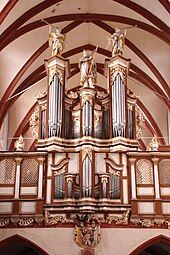Altenberg Monastery
The Monastery Altenberg is a former Prämonstratenserinnenkloster . It is between Wetzlar and Solms - Oberbiel on the Michelsberg above the Lahn .
history

In 1167 the priest Gottfried von Beselich founded a chapel dedicated to the Archangel Michael on the "old mountain" . He was also the founder of the Walsdorf monastery near Idstein and the Beselich monastery around 1170 near Obertiefenbach . The construction of the Lahn bridges in Wetzlar and Limburg is also attributed to him.
Around 1170 the Premonstratensian monastery was built around this chapel. Abbot Engelbert von Rommersdorf sent 12 Wülfersberg virgins to redesign the St. Nicholas Chapel of Altenberg into a monastery. The mother monastery was thus the Rommersdorf Abbey . Many members of the noble families from the surrounding area, such as the House of Nassau and House of Solms , entered the monastery. The second master of the monastery was Christina von Biel, who with her fortune laid the foundation for the monastery's later wealth.
In 1248 Gertrud , the daughter of St. Elisabeth of Thuringia , became the third master of the convent ; she held this office for 49 years. The monastery experienced a boom under Gertrud. The monastery church was built between 1260 and 1270. The monastery acquired extensive estates on the Lahn, in the Wetterau and in the hinterland (including the Hülshof , now part of Bad Endbach ). Before 1192 Emperor Barbarossa granted the monastery imperial immediacy . Gertrud was venerated as a blessed after her death in 1297 . Gertrude's successor was Katharina von Nassau (1297–1324), an aunt of King Adolf von Nassau and sister of Otto I.
The Monastery Altenberg joined, as opposed to the nobles of the surrounding area, not the Reformation and formed a at Kurtrier remaining Catholic enclave . During the Thirty Years' War , the monastery was laid in ashes by Swedish soldiers in 1636, but was able to recover under Master Katharina von Derschen (1644–1655).
The Altenberg monastery was at times the burial place of the Solms family. The house of Solms tried to get the imperial bailiwick over the monastery. However, the monastery was able to maintain its imperial immediacy until 1802. After 1802 the monastery complex came into the possession of the princes of Solms-Braunfels as a result of the Reichsdeputationshauptschluss , who abolished the monastery and converted it into a domain and used the complex as a summer residence. They took numerous works of art from the monastery to other castles for protection. Parts of the winged altar from 1330 are now in Braunfels Palace , while the wings designed by an unknown master can be viewed in the Städel in Frankfurt. The arm reliquary of St. Elisabeth has been kept in the Sayn Castle chapel since the monastery was closed . The monastery church was converted into a Protestant parish church.
Since the end of the First World War, the monastery has served various purposes; among other things, a children's home was housed there after 1947. In 1952 the facility was badly damaged by fire. After the renovation in 1955, the Königsberger Diakonie der Barmherzigkeit , a community close to the Evangelical Alliance , leased the building as the mother house until 2054 . She ran a care facility here until 2010 . From 2009 to 2011, the Technical University of Central Hesse had offices in the former monastery and tried to establish part-time training. Due to an economic distress of the Königsberger Diakonie, the Kloster Altenberg non-profit GmbH took over the rights and obligations of the lease for three years from August 2010.
Lukas Haltiner, member of the Evangelical Community Christ Brotherhood Selbitz , initiated a spiritual community in 2018. The first six men have moved into the former nursing rooms and want to develop the Altenberg monastery further as a spiritual center.
investment
The church from the 13th century and the convent buildings are still preserved. There are also numerous farm buildings from the 17th century. The outer wall of the monastery almost completely encloses the complex.
Both the former monastery church and various exhibits in the sacred rooms of Braunfels Castle in Braunfels (Lahn-Dill district) can be visited.
organ
In 1757 Johann Wilhelm Schöler built the third organ . Previous instruments date from 1452 and 1653. Schöler's instrument has 23 registers, two manuals and a pedal. With the limited keyboards and soft but very colorful sounds, it is designed entirely for its liturgical function. Apart from maintenance-related adjustments and minor repairs, the baroque work has been preserved almost unchanged.
literature
- Albert Hardt: Document book of the monasteries Altenberg, Dorlar, Retters . Wolfenacker 2000
- Randolf Fügen: Highlights in Central Hesse . 1st edition. Wartenberg Verlag, Gudensberg-Gleichen 2003, ISBN 3-8313-1044-0 .
- Hermann-Josef Hucke (Ed.): Great Westerwaldführer . 3. Edition. Verlag Westerwald-Verein eV, Montabaur 1991, ISBN 3-921548-04-7 .
- Thomas Doepner: The Premonstratensian Convent Altenberg in the High and Late Middle Ages. Investigations in the history of social and piety . (Studies and materials on constitutional and regional history; 16), Zugl .: Cologne, Univ. Diss., Hrsg. Hessisches Landesamt für Geschichtliche Landeskunde, NG Elwert Verlag, Marburg 1999, ISBN 3-7708-1128-3
- The founder of the Orange Line is buried on the Altenberg, Wetzlarer Neue Zeitung, April 11, 2016
Web links
- Altenberg Monastery , website of the Königsberger Diakonie meeting center
- Altenberg Premonstratensian Convent. Monasteries. In: Landesgeschichtliches Informationssystem Hessen (LAGIS).
- Altenberg, Premonstratensian In: Archive Information System Hessen (Arcinsys Hessen).
- State Office for the Preservation of Monuments Hesse (Ed.): Complete system of Altenberg Monastery In: DenkXweb, online edition of cultural monuments in Hesse
Individual evidence
- ^ Nassau, Katharina Countess of. Hessian biography. (As of April 29, 2019). In: Landesgeschichtliches Informationssystem Hessen (LAGIS).
- ↑ New Spiritual Community in Altenberg Monastery , Idea , article from January 4, 2019.
Coordinates: 50 ° 33 ′ 30.8 ″ N , 8 ° 26 ′ 42.7 ″ E

